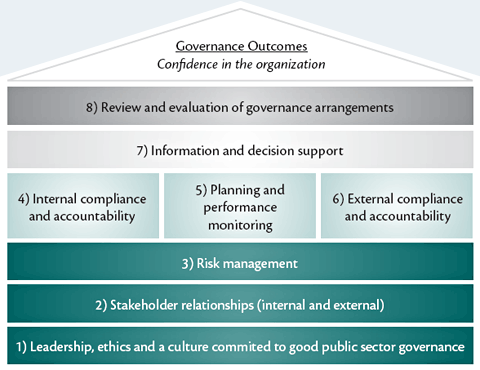"Regardless of organizational type, corporate governance regimes are unlikely to be effective where there is a lack of clarity about the participants involved, their relationships with each other and their respective responsibilities."
Board Resourcing and Development Office of British Columbia,
Best Practice Guidelines, (February 2005, p. 3)
The elements that constitute good public sector governance, and upon which practices can be modelled, can be demonstrated as the components of a house, Click on sections of the house to find out more.

Source: Australian National Audit Office, "Public Sector Governance", 2003.
1) Leadership, ethics and a culture committed to good public sector governance
The implementation, evaluation and improvement of a public sector organization's governance structures and processes are the responsibility of leaders, and without such commitments, there would be no foundation to build on.
2) Stakeholder relationships (internal and external)
Understanding the various roles, accountabilities and needs of each stakeholder group contributes to strong relationships, and supports the success of the three central components, or "windows", of the "House of Governance".
3) Risk management
This provides a public sector organization with the means to understand and address risks in order to better achieve its objectives.
4) Internal compliance and accountability
An efficient and well-governed public sector organization will ensure that internal controls and accountabilities are clearly defined and consistent with the organization's objectives.
5) Planning and performance monitoring
Governing bodies that review and foster better planning and performance monitoring will be more effective and relevant.
6) External compliance and accountability
External scrutiny is an integral part of work in the public service and meeting these accountabilities is one of the measures of success for public sector organizations.
7) Information and decision support
Information management is critical for a public sector organization to meet its objectives and accountabilities, namely by ensuring that the right information gets to the appropriate people in a timely manner.
8) Review and evaluation of governance arrangements
Ongoing review, evaluation and adjustments of governance arrangements are a key process and this includes the governing body checking its own structures, processes and overall performance.
